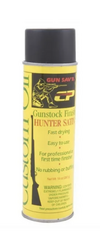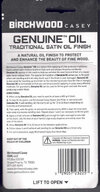yes, but the application is the same, And, while I like tung better, linseed can be used interchangeably. In fact, I’ve used warm linseed the get better penetration In early stages. Same with tung.
Carefully read the part about sanding using the oil as a wetting agent to fill the grain. This is early stage and important if you want a level finish that is not “potted” with unfilled grain.
These will be heavier coats that are allowed to dry hard. Wet sand until the finish appears to be gone. You should get a little slurry. This is what will fill the grain. Rub slurry into wood. Do not use steel wool, it will pull the finish out of the wood pores. Use a small block of wood to wrap the sandpaper around, Recoat, sand very lightly to provide grip for the next coat. Do this until the wood surface is filled And level.
Fir finish maintenance, Andrew took one finger and rubbed down the entire butt stock, What you want to avoid is heavy swirls that are left to dry. Those would have to be smoothed with 600 grit. Rub, rub, rub in until all you’re seeing are really thin swirls - more like smears.. Take your palm and get the swirls/smears smoothed out in line with the grain. Dry. Do again. This may take multiple thin coats.
You cannot screw this up. You may have to rework with sandpaper, but that is just more work - not disaste. 600 grit is your friend (I have grits to 1,000 as well as micro grits which are barely sandpaper) 600: 800 will do you to correct places you don’t like. Avoid steel wool until you’re doing touch up down the road.
If you allow the final stages of oil to dry too hard and oil doesn’t seem to spread right, use the finest grade of steel wool you can find. Wet it with finish and, very lightly, “break” the surface so the next coat you rub in will grab ahold.
Good luck. Been where you are, glad I’m passed that stage. When you get done, finishes will easier for you.

 www.birchwoodcasey.com
www.birchwoodcasey.com






